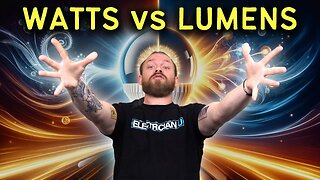Premium Only Content

Lamps & Bulbs Electricians Should Know - Incandescent, Fluorescent, HID, Halogen, LED
There are so many different types of lamps out there that having an understanding of the "lamp families" helps you understand how to troubleshoot them easier. Let's dive in.
👾🤖PRACTICE EXAMS🤖👾
https://www.electricianu.com/practice-exams
😎👕MERCH👕😎
https://www.electricianu.com/merchandise
📲👥SOCIALS👥📲
Instagram - https://www.instagram.com/electrician_u
Discord - https://discord.gg/7ykYfbh
Facebook Page - https://www.facebook.com/theelectricianu
Facebook Group - https://bit.ly/2tz7eQh
TikTok - https://www.tiktok.com/@electricianu
SPONSOR
ROGERS: https://www.rogersservices.com
Text "ROGERS" to 97211 to apply
INCANDESCENT
Incandescent lamps are probably the most known lamps out on the market. When the average person thinks about a light bulb, they tend to imagine an incandescent filament bulb. Incandescent lamps have been used for decades to illuminate homes, roads, businesses, and much more. They were the most widely used lamp of the 20th century as they led the way in illumination from the origin of the light bulb until now.
Incandescent bulbs use a tungsten metal filament on the inside, that has a certain amount of resistance from one end to the other. When you send current through the lamp this filament gets so hot that it begins to glow. This glowing is what the lamp uses to illuminate a room. Every type of lamp has some sort of inert gas on the inside that helps create a “jacket” around the tungsten filament to minimize oxidization. In incandescent lamps this gas is argon. Some other lamps like high-pressure sodium HID’s use xenon instead.
To find out if an incandescent lamps is good you can normally visually inspect the filament. If it appears broken then most likely the lamp is bad. If you’re unsure, or you have a frosted lamp, you can take your tester out and switch it to “continuity” and test from the metal tip of the bottom side of the lamp, to the metal screw-shell. You should hear a continuous tone from the tester. If there’s no tone, then more than likely the filament is broken and the lamp is bad.
HALOGEN:
Halogen’s are a slightly different “family” of lamps than incandescent but they operate very similarly so often times they’re still considered incandescent light sources. A halogen lamp still has a tungsten filament inside of them, but they normally put this filament inside of an inner quartz tube deep inside the lamp. The quartz tube is typically filled with an amalgam of Halogen gasses rather than Argon. The halogen gas does a couple of things - it helps reduce breakdown of the tungsten filament and re-deposits the suit flaking off of the element back onto the element. The reason they’re designed this way is that a typical incandescent lamp wastes a lot of energy when illuminating. Designing a smaller filament with a smaller quartz tube, filled with Halogen gasses, allows a lot of that energy to be captured allowing the lamp to operate more efficiently.
The temperature inside of the quartz tube is extremely hot, and the glass surrounding the element is so close to the filament that it actually needs to be stronger than glass - so it doesn’t melt. This is why they make it out of quartz instead.
FLUORESCENT:
Fluorescent lamps are probably the next most-used light source on the market. These are used in kitchens, garages, shops, retail stores, office buildings, shopping centers, manufacturing plants, and much more. Fluorescents are very efficient lamps in that they don’t rely on a metal filament to glow, but rather strike an arc that is regulated by a ballast as the source of illumination.
When a fluorescent lamp ignites electrons are sent back and forth from one end of the tube to the other until an arc forms. Once this arc stream reaches a certain temperature a small deposit of mercury, inside the lamp, melts and vaporizes into the arc stream. This mercury creates UV light which is typically very bad radiation for a human to take on their skin. For this reason almost all fluorescent lamps are coated on the inside with a white phosphor powder. This does more than just sheild from UV radiation, it actually glows when it interacts with UV light. So fluorescence is a type of phosphorescence. It’s literally an arc stream that makes phosphor glow as a result of the UV radiation let off by the mercury arc stream inside of the lamp. Pretty cool huh?
CONTINUE READING FULL ARTICLE AT https://www.electricianu.com/podcast/episode-28-types-of-lamps/bulbs-electricians-should-know-lamp-bulb-families
#lamps #bulbs #hid #lamptypes #bulbtypes
--
Subscribe - https://www.youtube.com/c/electricianu?sub_confirmation=1
IF YOU ENJOY THESE VIDEOS PLEASE SUBSCRIBE AND "LIKE" THEM ABOVE. ALSO CHECK OUT THE ELECTRICIAN U PODCAST ON ITUNES AND SPOTIFY!!
-
 6:27
6:27
Electrician U
1 year ago💡 Watts vs Lumens: The New Lighting Standard You Need to Know! 💡
7.56K6 -
 2:12:26
2:12:26
Inverted World Live
6 hours agoManhunt for Suspect in Charlie Kirk's Assassination Continues, NASA Reveals "Life" on Mars | Ep. 107
229K34 -
 2:44:02
2:44:02
TimcastIRL
8 hours agoMedia Warns Of Civil War Following Charlie Kirk Assassination | Timcast IRL
428K320 -
 2:59:56
2:59:56
Laura Loomer
8 hours agoEP143: Remembering Charlie Kirk (1993–2025)
93.3K68 -
 58:04
58:04
Man in America
11 hours agoCharlie Kirk’s Assassination—An URGENT WARNING for America
87.2K98 -
 1:22:15
1:22:15
Glenn Greenwald
9 hours agoCharlie Kirk Assassination Fallout: U.S. Reps Call for Censorship; Do Graphic Videos Serve the Public Interest? Plus: WIRED Reporter on the Dark Side of Surrogacy | SYSTEM UPDATE #513
203K175 -
 1:48:36
1:48:36
Right Side Broadcasting Network
16 hours agoLIVE: President Trump Attends the Yankees Baseball Game - 9/11/25
176K25 -
 1:54:32
1:54:32
Badlands Media
10 hours agoBadlands Media Special Coverage - FBI Press Conference on Charlie Kirk's Assassination
145K20 -
 1:06:19
1:06:19
BonginoReport
11 hours agoManhunt Underway for Charlie Kirk’s Assassin - Nightly Scroll w/ Hayley Caronia (Ep.132)
312K247 -
 1:11:42
1:11:42
Flyover Conservatives
19 hours agoStructural Architect Destroys 9.11 Narrative... What Really Happened? - Richard Gage AIA | FOC Show
98.6K17